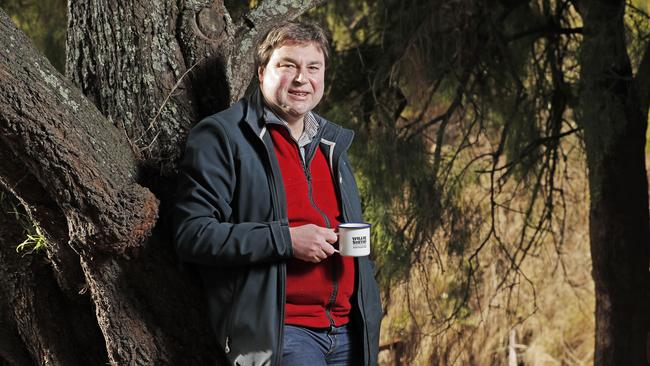Landcare funding: Getting down and dirty to meet earth’s demands
Our green army is growing, and so are their expectations, but there’s one thing that’s holding them back, says the chief executive of Landcare Tasmania.

Tasmania
Don't miss out on the headlines from Tasmania. Followed categories will be added to My News.
A MAP of Tassie in Rod Knight’s office lists all the things he and his colleagues don’t do. It’s not a down-tools demarcation document but a poster Landcare Tasmania staff produced as a shout-out to its volunteers.
“We don’t plant trees, pull weeds or care for our bush, coasts and soils…” it reads, “but we know LOTS of people who do.”
Rod’s challenge as the state organisation’s chief executive is to find more funding to facilitate people’s growing willingness to get down on their hands and knees to do their bit for the environment.
Our green army is growing fast and funding is not keeping up with the community’s desire to contribute more.
Landcare Tasmania’s membership has surged over the past three years, a trajectory that coincides with Rob’s arrival at the charity and escalating community concern about climate change impacts and local sustainability issues.
MORE CAFE SOCIETY:
BRYAN WALPOLE: HEALTH SYSTEM NEEDS FULL REBUILD
KATHERINE STREET: FLOURISHING IN A CHANGING LANDSCAPE
WARRICK BISHOP: A HELPING HAND FOR YOUR HEART
SHAMUS MULCAHY: MISSING ELEMENT IN HEIGHT DEBATE
CHRIS GWYNNE: HYDROPOWER TO TACKLE CLIMATE CHANGE
We meet in the field, sharing a thermos of tea beneath a big blackwood tree in Sandy Bay’s Lambert Gully Reserve, where Rod spent National Tree Day last Friday, planting along the gully bank with girls from Mt Carmel College’s new Landcare group.
Seventy of the organisation’s 230 groups have joined in the past three years. Rod estimates that last year members and regular volunteers gave 135,000 labour hours to the cause.
“I can’t see any slowing down in the community wanting to get involved,” he says. “Local communities are realising there’s a raft of issues they’re going to have to take responsibility for if they want to have them addressed. In some ways,
“I have to put the brakes on, because I have to manage the expectations that come with getting involved.”
He says the dollar value of those volunteer hours is about 20 times greater than the amount the organisation receives in funding.
Projects around the state are increasingly diverse. Weed control remains a mainstay (Rod speaks admiringly of an East Coast woman who has trained her dog Fonzie to sniff out a specific tussocky weed).
Soil generation groups are flourishing and tree-planting days are still common — and, despite what the map says, Rod did get his hands dirty here on Friday.
Is National Landcare’s funding system broken, as some of Rod’s interstate colleagues say?
He stops short of that assessment, but he is calling for a Commonwealth funding model shake-up.
“There are problems with the funding focus,” he says. “The amount accessible to community Landcare groups to address the issues that are of concern to them is embarrassingly small.
“It means we have a gap between the willingness of the community to take things on and the priorities the Commonwealth has chosen to put on its funding.
“The Landcare space is split between the Agriculture and Environment ministries. And in the environment space in particular the Commonwealth has taken a very narrow focus of what it is willing to put money into.
“There’s only a narrow range of issues people can choose to work on,” Rod says. “And it’s harder for a group that wants to look after their patch of local bush, like the one we are in now, to access money to lavish care on it.”
Protected area management programs are also being given access to funding earmarked for Landcare, he says. “This gives a false impression that the Commonwealth is a bigger supporter of Landcare than it actually is.”
He says the Federal allocation of $1.1 billion over five years funding for Landcare nationally is so whittled down and dispersed in real terms that available funds are at an all-time low. The Landcare movement launched 30 years ago, when farmers and environmentalists came together to address land degradation issues, with Landcare Tasmania forming five years later.
Much of its work today is in more densely populated areas, but Rod is keen to rebuild close rural ties.
“When the Government changed its funding model in the early 2000s, it pretty much gutted the Landcare activity in the farming sector,” he says. “This contraction concerns us enough that we’ve developed a specific strategy to rebuild it.
“Farmers manage so much of the landscape and it’s really important that they’re managing sustainably, that they are supported and that their contributions are valued.”
Rod also wants business to step up. Many local firms make small contributions to Landcare Tasmania, which has also distributed $600,000 from a philanthropic trust over the years.
Part of the plan now is to match specific Landcare projects with specific sponsors and to form more partnerships with like-minded bodies including councils.
“More broadly, I think business contributing more towards environment is an inevitable part of the future,” says Rod. “I don’t think we’ll ever get completely away from businesses that just want to make their money through greed, but I think the overall business environment is shifting.
“There is change. Whether it’s fast enough to make the type of changes that are needed I’m not sure. In Tasmania, we have a way to go.”


